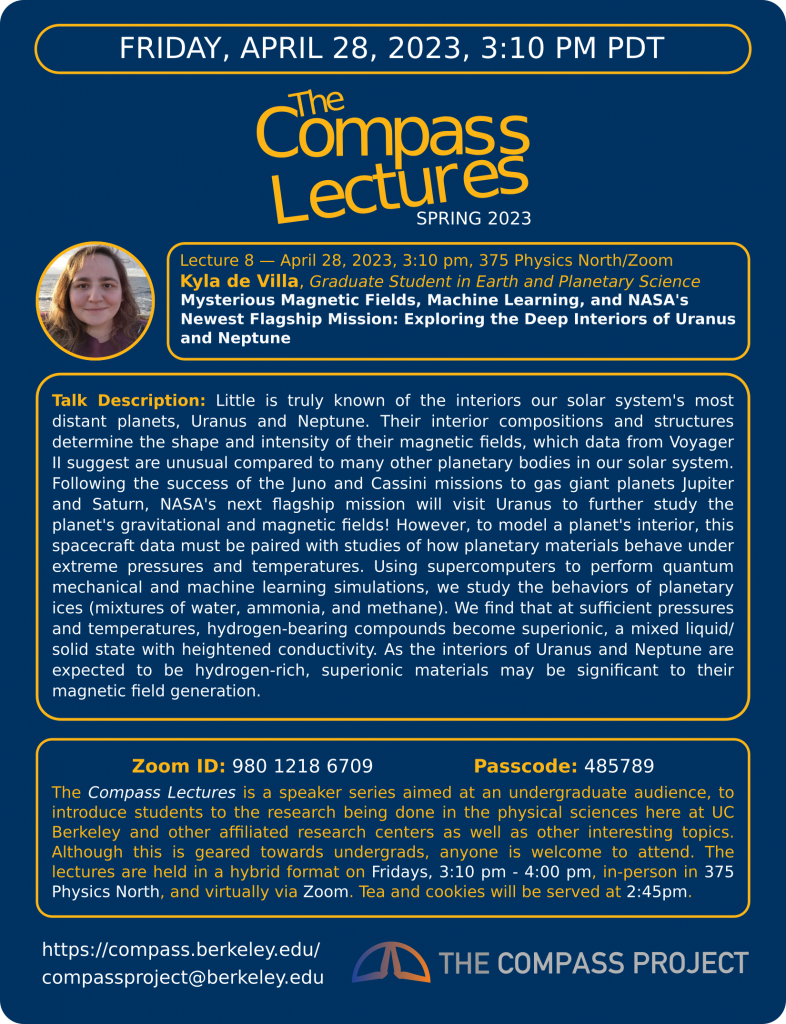
The Spring 2023 Lectures:
Lecture 1 (Friday February 17th, 2023):
Ultracold Titanium: Bringing a New Element to Quantum Degeneracy
Lecture 2 (Friday February 24th, 2023):
Lecture 3 (Friday March 3rd, 2023):
Lecture 4 (Friday March 10th, 2023):
My winding path through physics & astronomy
Lecture 5 (Friday March 24th, 2023):
Integration and Deployment of Simons Observatory Small Aperture Telescope
Lecture 6 (Friday April 7th, 2023):
The Moonbounce Project: Assessing Earth’s Technosignature
Lecture 7 (Friday April 21st, 2023):
Stellar Chemistry in the Faintest and Farthest Local Group Galaxies
Lecture 8 (Friday April 28th, 2023):
Ultracold Titanium: Bringing a New Element to Quantum Degeneracy
Diego Novoa, PhD Candidate
Date & Time: Friday, February 17th, 2023, 3:00 pm – 4:00 pm
Location: 375 Physics North
Talk Description: When a gas of atoms is cooled to extremely low temperatures, the quantum nature of matter becomes strikingly apparent. These ultracold systems can be used to study a vast range of different phenomena, ranging from fundamental quantum mechanics to material science. Adding new atoms to the periodic table of ultracold science expands the scope of what can be studied. With this in mind, I will talk about our efforts to make the first ultracold gas of titanium and the potential applications.
Recording: https://youtu.be/ALVm6npMG5Y
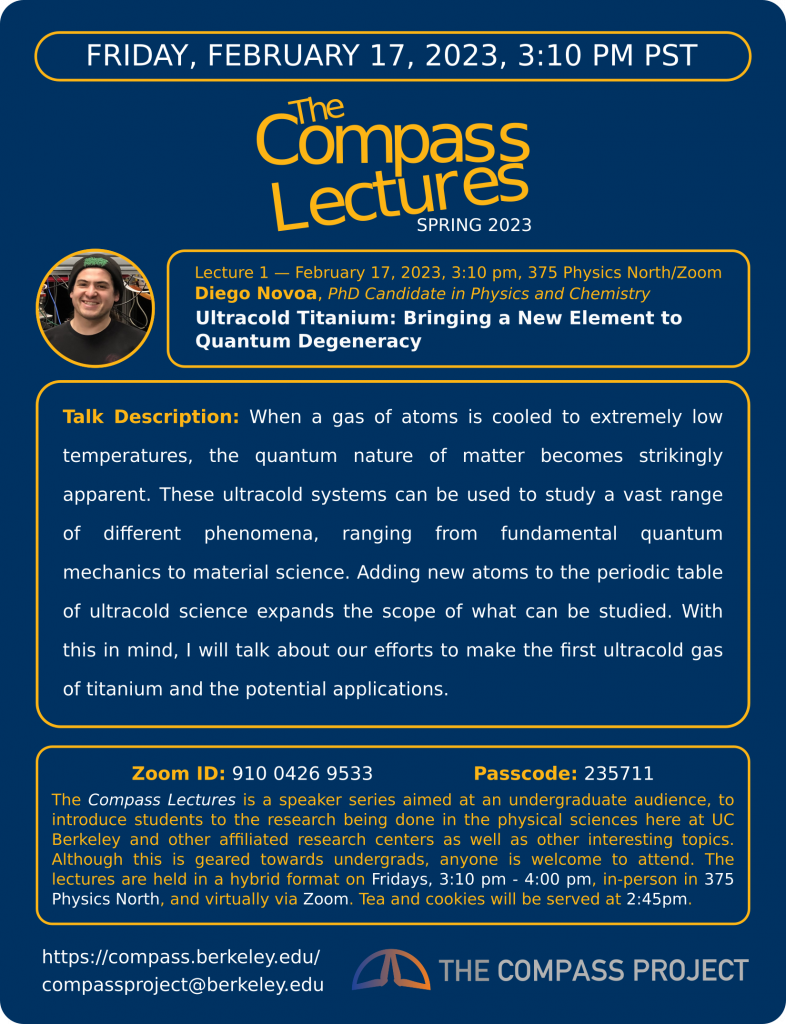
What’s going on down there? An experimental exploration of intergranular dynamics in deep Earth using high-pressure and high-temperature synchrotron X-ray diffraction techniques
Michelle Devoe, PhD Candidate
Date & Time: Friday, February 24th, 2023, 3:00pm – 4:00pm
Location: 375 Physics North
Talk Description: The deep Earth is comprised of a mush of grains of various shapes and sizes. How do these grains behave when subjected to stress, like mantle convection, or the forces of tectonic activity? Our understanding of the composition, structure, and behavior of the deep Earth has historically relied primarily on seismic observations, yet seismic waves provide only a low resolution image of deep Earth. To get a closer look, I use experimental high pressure and temperature techniques, combined with synchrotron X-ray diffraction techniques, to simulate deep Earth conditions and study intergranular dynamics of minerals found in the deep Earth. These microscopic behaviors detail our understanding of seismic signals, and may play a large role in global processes like mantle convection, and tectonic plate movement when scaled up.
(No Recording)
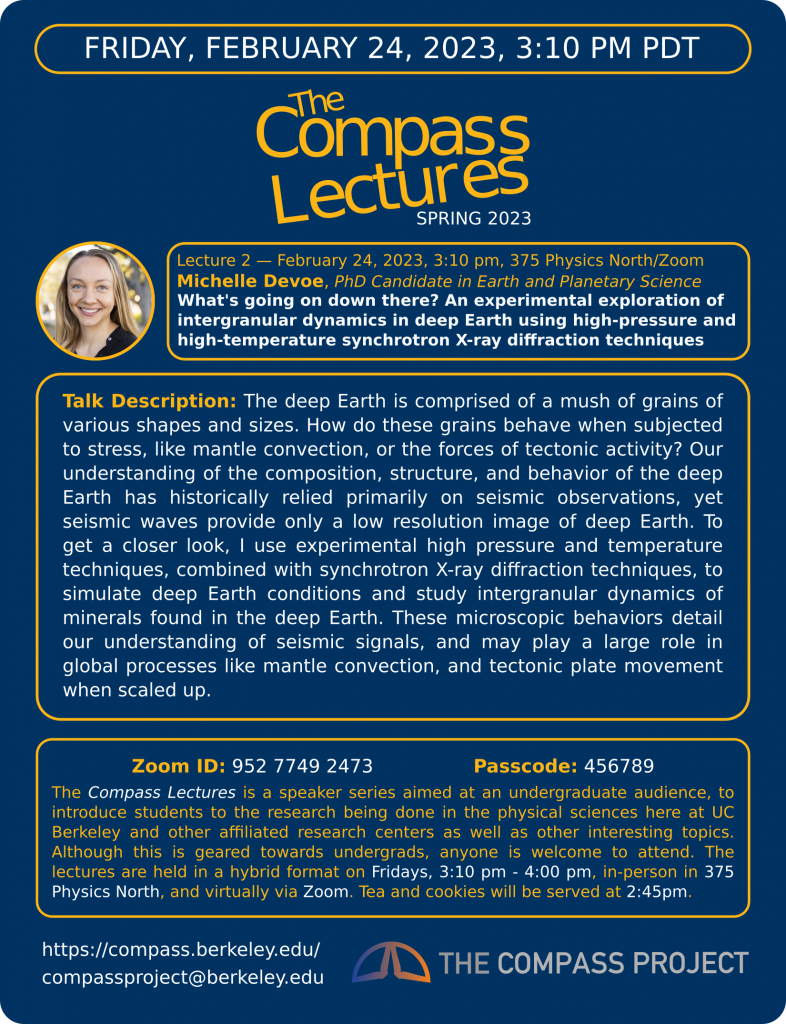
The stuff of stars
Raúl Briceño, Professor
Date & Time: Friday, March 3rd, 2023, 3:00pm – 4:00pm
Location: 375 Physics North
Talk Description: Nuclear physics as a field is interested in answering a variety of questions. The ones that drew me to this field are in the more philosophical realm: Where did we come from? What are we made of? How were we created? My research focuses in using the basic principles of the subatomic world to better understand the answers to these questions.
Recording: https://youtu.be/jMpnmgYaUGw
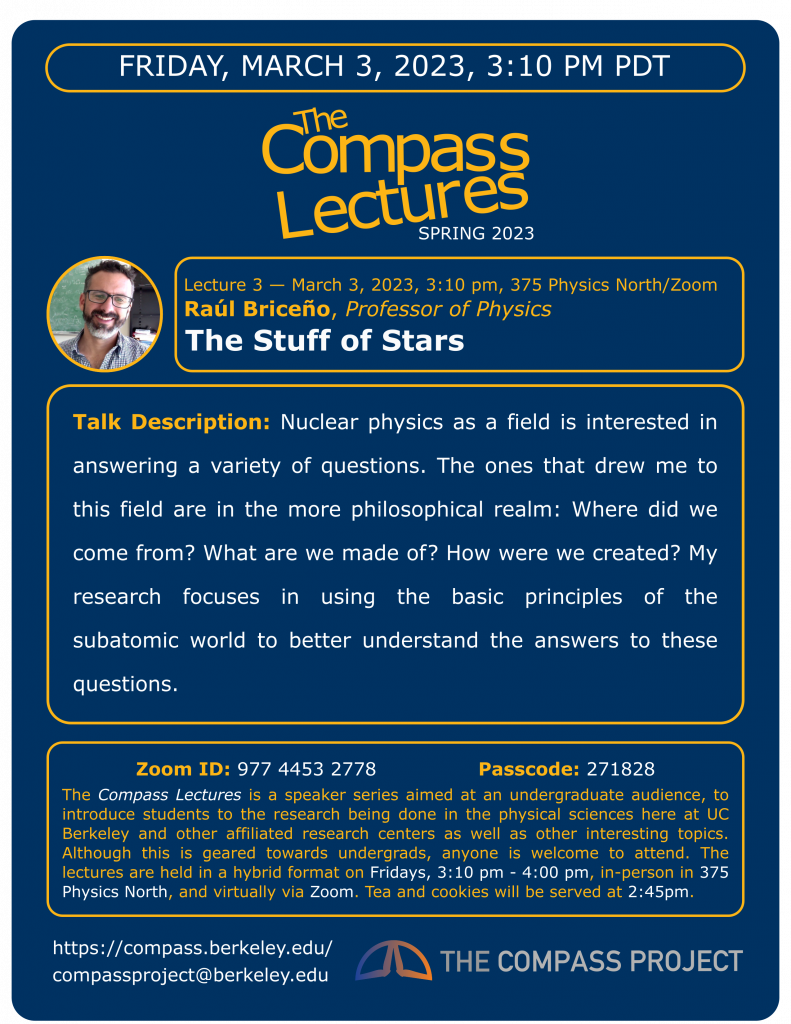
My winding path through physics & astronomy
Guy Nir, Postdoctoral Researcher
Date & Time: Friday, March 10th, 2023, 3:00pm – 4:00pm
Location: 375 Physics North
Talk Description: Can’t really choose what to study? Thinking maybe research could be interesting but you’re not sure? Story of my life. In this talk I will go over the scientific topics I had been researching in different stages of my studies, talk about the decisions I’ve made and try to justify (to myself?) a zigzaging path between physics, astronomy and software development that has taken me from a clueless physics major to a clueless postdoc here in Berkeley.
Recording: https://youtu.be/pKG-gIfwrIc
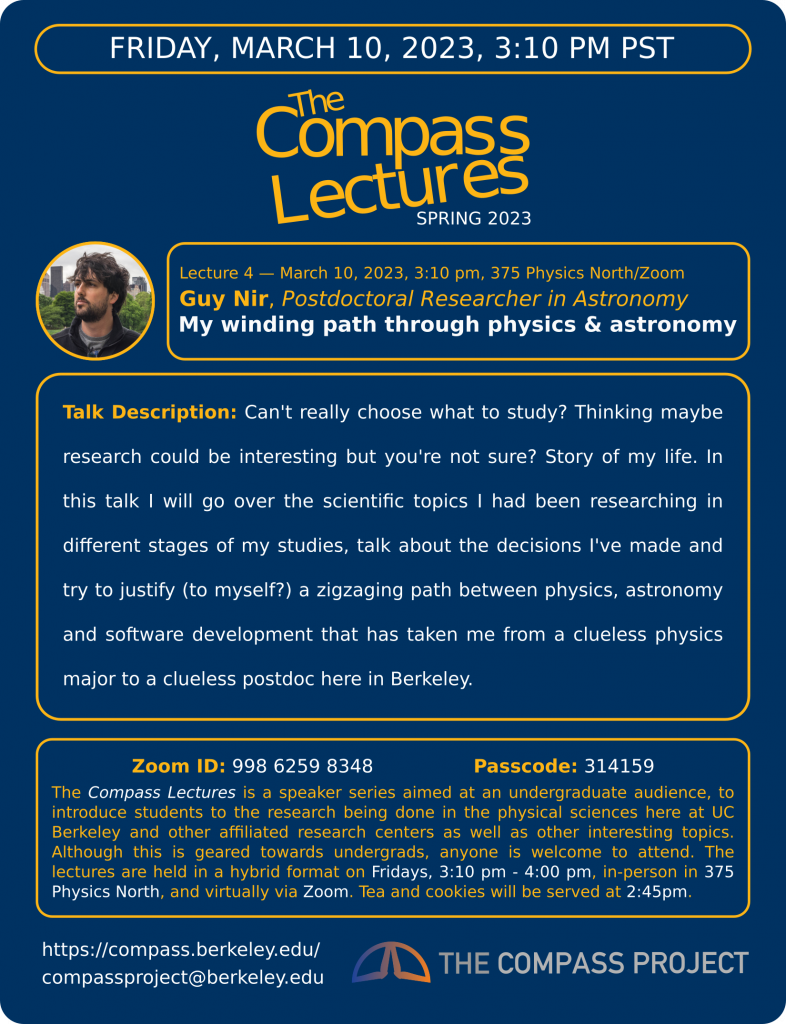
Integration and Deployment of Simons Observatory Small Aperture Telescope
Aashrita Mangu, Graduate Student
Date & Time: Friday, March 24th, 2023, 3:00pm – 4:00pm
Location: 375 Physics North
Talk Description: The Simons Observatory is a cosmic microwave background (CMB) experiment located in the Atacama Desert in Chile at an elevation of 5300m. We aim to take next-generation data of the CMB, a relic from the big bang and some of the oldest light we can observe to better understand the beginnings of our universe. The current plan is to deploy three small aperture telescopes (SATs) and one large aperture telescope (LAT), with a possible expansion to more telescopes. We house and build one of the three SATs right up the hill at Lawrence Berkeley National Lab. I will discuss what building and deploying one of these telescopes involves, and why the science it does is important!
(No recording available)
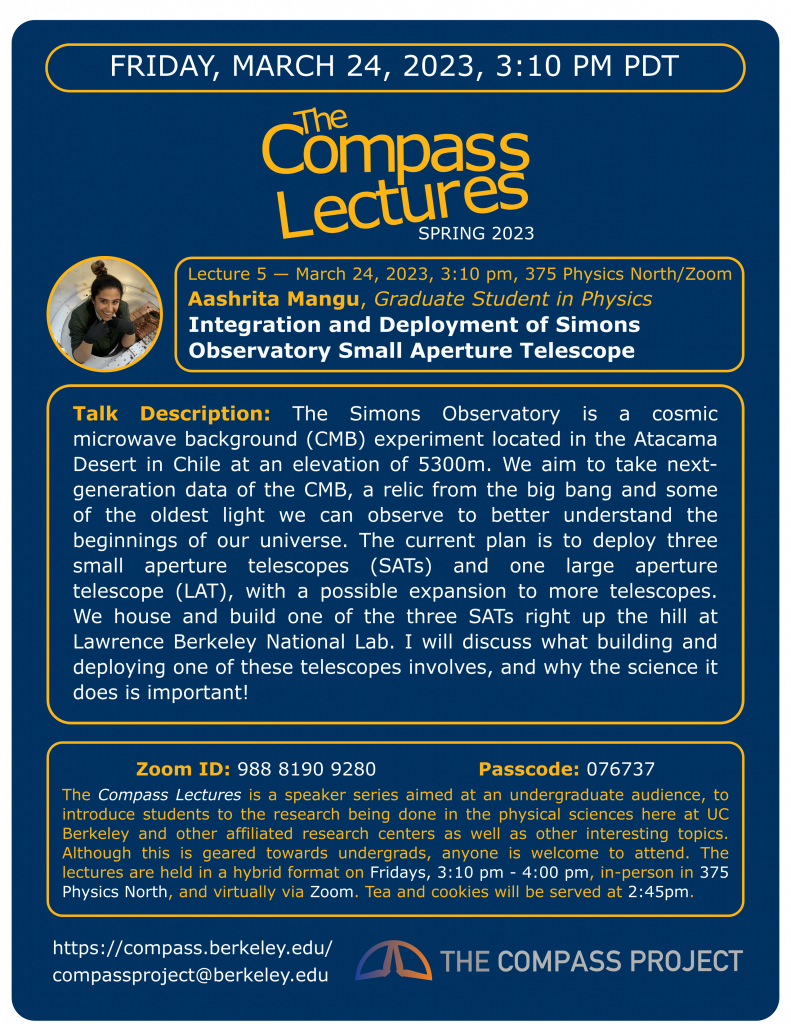
The Moonbounce Project: Assessing Earth’s Technosignature
Julia DeMarines, Graduate Student
Date & Time: Friday, April 7th, 2023, 3:00pm – 4:00pm
Location: 375 Physics North
Talk Description: How detectable is Earth from the vantage point of an ET onlooker? In this presentation I will discuss how we use large radio telescopes to observe Earth’s radio leakage (or technosignature) using the Moon as a mirror reflecting radio light. The Moonbounce project measures the current signal power of Earth’s transmissions and compare it to previous studies in the 80’s and 2000’s.
Recording: https://youtu.be/LNu53pfC4gQ
Stellar Chemistry in the Faintest and Farthest Local Group Galaxies
Nathan Sanford, PhD Candidate
Date & Time: Friday, April 21st, 2023, 3:00pm – 4:00pm
Location: 375 Physics North
Talk Description: Ultra-faint dwarfs (UFDs) are the oldest, lowest mass, and most metal-poor galaxies in the local Universe, and the chemistry of their stellar populations encode a wide range of astrophysical insight on everything from the composition of dark matter to the physics of star formation, stellar evolution, and chemical enrichment in the early universe. However, the faintness of stars in these small and distant galaxies requires long integration times using low-resolution spectrographs on the world’s largest telescopes in order to make the necessary measurements of stellar chemical composition. At low resolution, the severe blending of absorption lines in a star’s spectrum introduces additional, though not insurmountable, barriers to accurate measurements and the robust interpretation of UFD evolution. In this talk, I will discuss work that I have done to quantify and capitalize upon the enormous potential of low-resolution spectroscopic observations of galaxies throughout the Milky Way’s neighborhood. I will also demonstrate how chemical evolution models can constrain key physical processes driving the evolution of low-mass galaxies in the early Universe using recent observations of the UFD Eridanus II.
Recording: https://youtu.be/1jbu_aqCsQM
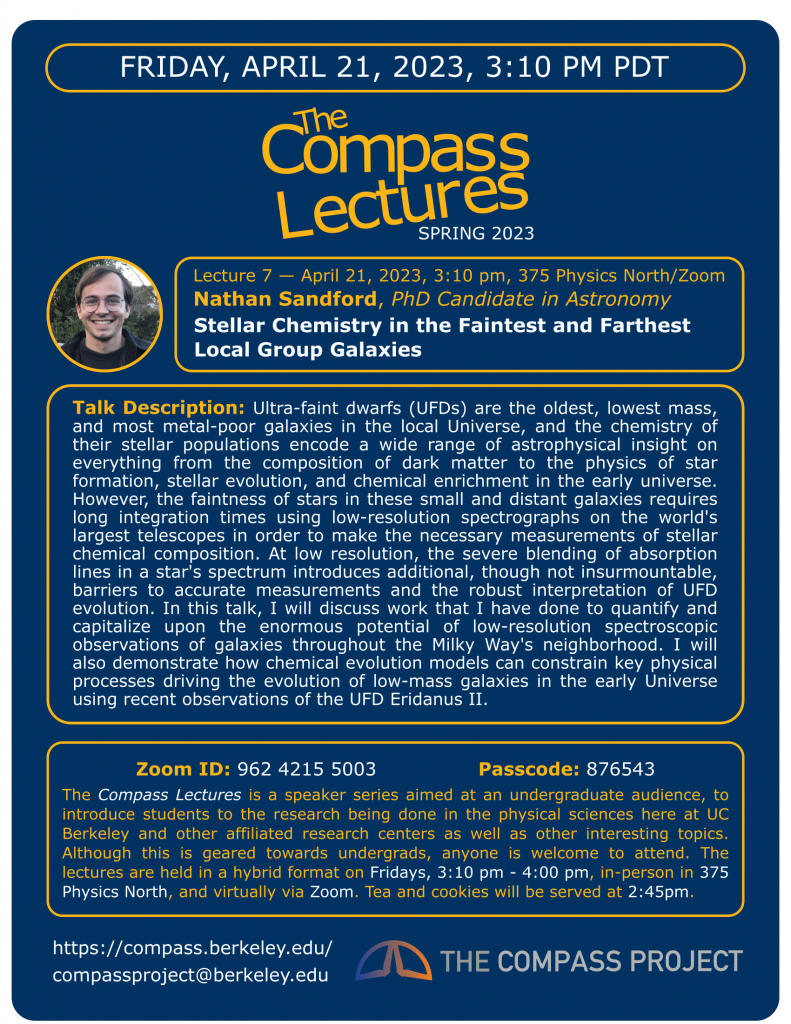
Mysterious Magnetic Fields, Machine Learning, and NASA’s Newest Flagship Mission: Exploring the Deep Interiors of Uranus and Neptune
Kyla de Villa, Graduate Student
Date & Time: Friday, April 28th, 2023, 3:00pm – 4:00pm
Location: 375 Physics North
Talk Description: Little is truly known of the interiors our solar system’s most distant planets, Uranus and Neptune. Their interior compositions and structures determine the shape and intensity of their magnetic fields, which data from Voyager II suggest are unusual compared to many other planetary bodies in our solar system. Following the success of the Juno and Cassini missions to gas giant planets Jupiter and Saturn, NASA’s next flagship mission will visit Uranus to further study the planet’s gravitational and magnetic fields! However, to model a planet’s interior, this spacecraft data must be paired with studies of how planetary materials behave under extreme pressures and temperatures. Using supercomputers to perform quantum mechanical and machine learning simulations, we study the behaviors of planetary ices (mixtures of water, ammonia, and methane). We find that at sufficient pressures and temperatures, hydrogen-bearing compounds become superionic, a mixed liquid/solid state with heightened conductivity. As the interiors of Uranus and Neptune are expected to be hydrogen-rich, superionic materials may be significant to their magnetic field generation.
Recording: https://youtu.be/C3EY2udac10
